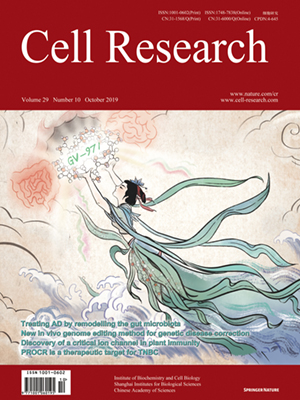
Volume 29, No 10, Oct 2019
ISSN: 1001-0602
EISSN: 1748-7838 2018
impact factor 17.848*
(Clarivate Analytics, 2019)
Volume 29 Issue 10, October 2019: 832-845
ORIGINAL ARTICLES
Protein C receptor is a therapeutic stem cell target in a distinct group of breast cancers
Daisong Wang1, Xin Hu2, Chunye Liu1, Yingying Jia1, Yiqin Bai1, Cheguo Cai1, Jingqiang Wang1, Lanyue Bai1, Ruikai Yang1,ChangDong Lin1, Yi-Rong Liu2, Shan Li2, Feng Qiao2, Ling Yao2, Li Chen2, Gaoxiang Ge1, Hai Jiang 3, Dianfan Li 4, Lin Li 1,JianFeng Chen1, Zhi-Ming Shao2 and Yi Arial Zeng 1
1State Key Laboratory of Cell Biology, CAS Center for Excellence in Molecular Cell Science, Institute of Biochemistry and Cell Biology, Chinese Academy of Sciences, University of Chinese Academy of Sciences, Shanghai 200031, China; 2Key Laboratory of Breast Cancer in Shanghai, Department of Breast Surgery, Fudan University Shanghai Cancer Center; Department of Oncology, Shanghai Medical College, Fudan University, Shanghai 200032, China; 3Key Laboratory of Systems Biology, Innovation Center for Cell Signaling Network, Institute of Biochemistry and Cell Biology, Shanghai Institutes for Biological Sciences, Chinese Academy of Sciences, Shanghai 200032, China and 4State Key Laboratory of Molecular Biology, National Center for Protein Science Shanghai, Shanghai Science Research Center, Institute of Biochemistry and Cell Biology, Shanghai Institutes for Biological Sciences, Chinese Academy of Sciences, Shanghai 200031, China
Correspondence: Zhi-Ming Shao (zhimingshao@yahoo.com) or Yi Arial Zeng (yzeng@sibcb.ac.cn)These authors contributed equally: Daisong Wang, Xin Hu
Breast cancer is a heterogeneous disease. In particular, triple-negative breast cancer (TNBC) comprises various molecular subgroups with unclear identities and currently has few targeted treatment options. Our previous study identified protein C receptor (Procr) as a surface marker on mammary stem cells (MaSCs) located in the basal layer of the normal mammary gland. Given the possible connection of TNBC with basal layer stem cells, we conducted comparative analyses of Procr in breast cancers of mouse and human origin. In mouse mammary tumors, we showed that Procr+ cells are enriched for cancer stem cells (CSCs) in Wnt1 basal-like tumors, but not in Brca1 basal-like tumors or PyVT luminal tumors. In human cancers, PROCR was robustly expressed in half of TNBC cases. Experiments with patient-derived xenografts (PDXs) revealed that PROCR marks CSCs in this discrete subgroup (referred to as PROCR+ TNBC). Interfering with the function of PROCR using an inhibitory nanobody reduced the CSC numbers, arrested tumor growth and prevented rapid tumor recurrence. Our data suggest a key role of MaSC in breast tumorigenesis. Moreover, our work indicates that PROCR can be used as a biomarker to stratify TNBC into clinically relevant subgroups and may provide a novel targeted treatment strategy for this clinically important tumor subtype.
https://doi.org/10.1038/s41422-019-0225-9
FULL TEXT | PDF
Browse 1154


